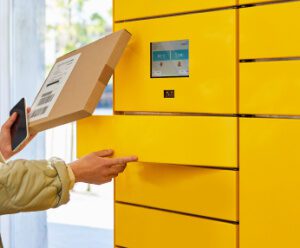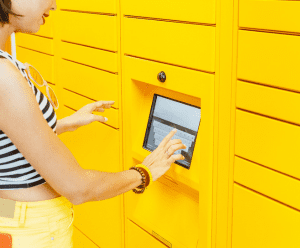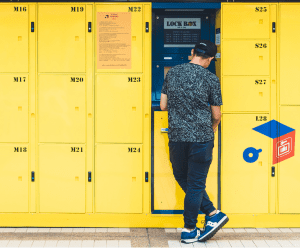
Everything you need to know about parcel lockers

Parcel lockers, also called smart lockers or package lockers, are secure, automated storage units in centralized locations. They are revolutionizing how goods can be delivered and received.
As a technologically enhanced version of a traditional locker, a smart locker incorporates digital and IoT (Internet of Things) features to make package management more convenient, secure, and efficient.
Retail companies, logistics firms, and their customers in the Asia Pacific region and elsewhere increasingly turn to parcel lockers as a preferred delivery solution.
The global parcel locker market is projected to reach US$2,073.4 million by 2030, up from US$806.6 million in 2022. This represents a compound annual growth rate (CAGR) of 12.6 percent.
With this explosive growth in the use of parcel lockers, it is important to understand what they are, how they work, and how they impact businesses and their customers.
What is a parcel locker?
A parcel locker is a secure, automated postal box that lets customers securely collect packages and oversized letters. People can pick up a package from a locker at a time that suits them, in a convenient location near their residence or workplace.
The lockers are designed to simplify delivery and pickup. They provide a flexible, convenient delivery option for customers, while centralizing a drop-off point to optimize last-mile delivery. As such, they have become especially popular in countries like China, where soaring e-commerce parcel volumes have rendered them indispensable.
Parcel lockers are considered ‘smart’ because they integrate with digital systems for monitoring, authentication, and communication.
Where are parcel lockers located?
Parcel lockers are usually placed in convenient, central locations that are easily accessible by many people. This includes apartment complexes, office buildings, business centers, shopping malls, education campuses and dormitories, hotels, public locations (such as parks, central business districts, and libraries), and warehouses or distribution centers.
How does a parcel locker work?
When a carrier delivers a package to a designated parcel locker location, they access the system using a unique access code or digital key. Once they place the package inside the locker, the recipient is notified via email, SMS, or a mobile app.
To retrieve the package, the recipient visits the locker at their convenience, uses the access code provided, scans a QR code, or connects to the locker with a mobile app. After successful authentication, the door automatically unlocks.
Customers no longer need to liaise with delivery personnel, skipping the hassle of one party waiting for another. Instead, customers can retrieve a package on the way to work, during their lunch break, or at any other convenient time.
Some parcel lockers even offer reverse logistics options, enabling recipients to initiate returns through the system. This would likely involve scanning a barcode, placing the item back in the locker, and confirming the return.
How does an apartment parcel locker network operate?
Apartment parcel locker networks are increasingly sought after for multi-unit residential complexes – usually in a central location such as a lobby.
When a carrier delivers a package to an apartment building, they scan the package barcode and enter the recipient’s information into the parcel locker system.
The system assigns a locker to the package, generates an access code or QR code for that locker, and automatically sends a notification to the apartment resident. The resident uses the code to access the locker. Once the package is retrieved, the door automatically shuts.
The system records deliveries and retrievals, enabling a secure chain of custody for all packages. Some systems also support returns.
Apartment parcel locker networks typically operate 24/7, enabling residents to retrieve packages at their convenience.
Many systems have user-friendly touchscreens, mobile apps, and web interfaces. Building managers may also have access to a control panel to monitor system status, view usage statistics, and manage locker assignments.
What does it mean when my package is delivered to a parcel locker?
When your package is delivered to a parcel locker, the delivery carrier – usually a postal service, courier company, or online retailer’s delivery service – has placed your package into a secure, automated locker.
To retrieve your package, you typically follow the instructions provided in the notification. This usually includes a unique access or QR code to open the locker.
How do I know which parcel locker my package was delivered to?
The delivery notification you receive by SMS or email will tell you which locker to access. Other methods are to contact the delivery carrier, use a relevant mobile app or online platform, or check with an associated property management office. You can also visit the parcel locker area, as lockers are often labeled with numbers or other identifying information.
How can I track deliveries to a parcel locker?
Specific steps may vary, depending on the delivery carrier or the smart locker system technology. Generally, they involve keeping an eye on delivery notifications, which should include a tracking number. You can use the tracking number when visiting the carrier’s website or mobile app, accessing the parcel locker system’s online platform, or contacting the carrier’s or sender’s customer support service or helpline.
What happens if I don’t pick up my package from a parcel locker?
Parcel locker systems usually have a predetermined storage period ranging from 24 to 72 hours. If you do not retrieve your package within this period, the package may be removed and returned to the carrier’s distribution center.
After the maximum storage time allowed, your access code may become invalid. In this case, you may need to contact the carrier or property manager for a new code.
Depending on the carrier, you may be able to schedule a redelivery. The carrier may also initiate a return-to-sender process. And some parcel locker systems may charge a fee for extended storage periods.
How to set up a parcel locker?
Companies or property managers must undertake preliminary tasks before setting up a locker system. These may include performing a needs assessment, choosing a reputable locker provider, preparing a suitable site, ordering the lockers, and securing any required permits.
Once the lockers arrive, the owner or manager must install them according to the manufacturer’s guidelines. They then need to set up the software (including the user interface, access codes, and user accounts) and conduct comprehensive testing to ensure the system functions correctly.
Staff managing the system must be trained in the operation, maintenance, and troubleshooting procedures – and users onboarded with clear instructions.
Owners or managers must also implement security and access control measures (often including surveillance cameras), and establish a maintenance and support plan.
How to plan a parcel locker network?
Businesses must consider several questions when planning a parcel locker network. For example, is there a compelling need to improve last-mile delivery efficiency, enhance the customer experience, or reduce delivery costs? Does the business clearly understand its target market for a parcel locker service? Can it estimate the ideal locker capacity? And does the business have the required technology and security to manage the network?
In addition, the business needs to assess how intuitive and efficient the user interface and customer experience should be, as well as initiating associated payment and billing mechanisms.
Does the business have service-level agreements in place with relevant stakeholders, such as logistics partners, property managers, and end users? Can it comply with all relevant legislation, regulations, and standards? Does it have a comprehensive maintenance plan? And can it adequately train all stakeholders, such as customers, administrators, and property managers?
Does DHL have parcel lockers?
Yes. DHL parcel lockers are a convenient and secure way to deliver and pick up packages. They are available day and night, so recipients don’t have to wait at home for deliveries. Customers also have a week to collect shipments.
Thanks to an extensive network of DHL ServicePoints, there is likely to be a nearby location where a customer can pick up or ship packages. These are local retailers that DHL collaborates with to provide a convenient delivery point near your home or work.
How are parcel lockers transforming last-mile delivery?
With e-commerce booming, the need to ensure seamless, rapid ‘last-mile’ delivery – that is, the transportation of a package to its destination – has become a critical competitive battleground for retailers and logistics carriers.
Traffic congestion and delays, and their associated costs, often plague the final leg of a package’s journey from a distribution center to a customer’s doorstep. The availability of the intended recipient to receive the parcel is unpredictable, which can result in missed deliveries. This causes frustration for customers and delivery drivers alike.
These issues are compounded by the growing customer expectation that their purchases will arrive within a day, or even within hours.
To adapt, the global logistics industry uses transformative technologies to reconfigure last-mile delivery and modify how goods are transported and received. Technology-enabled parcel locker systems in centralized locations are one solution, contributing to a new era of convenience and efficiency for customers and businesses. They also offer a safer alternative to deliveries left on doorsteps, where goods are vulnerable to theft or damage, or may be ruined due to poor weather conditions.
In China, Cainiao smart lockers use facial recognition technology for pickups. The lockers are so intelligent that a person’s photo or video cannot deceive them. And users can easily update their delivery account whenever their appearance changes.
Many lockers are also equipped with advanced security features like CCTV surveillance, secure access codes or biometric authentication. This means customers know their packages will be safe until collected.
Retailers and carriers are reaping the rewards of the parcel locker revolution. For example, consolidating the delivery of multiple packages for more than one recipient in a single parcel locker location in one trip reduces the fuel, labor, and vehicle maintenance costs incurred by traditional last-mile delivery methods.
With predetermined locker locations, delivery drivers can also optimize routes, minimizing the time spent navigating congested urban areas.
Can parcel lockers contribute to greener logistics?
Parcel locker systems are a positive alternative in terms of their low environmental impact. They are becoming essential to logistics carriers’ wider sustainability strategies as businesses and consumers seek greener delivery solutions.
Traditionally, last-mile delivery has been one of the most resource-intensive and environmentally consequential components of the parcel delivery process. Carbon emissions increase with more cars, vans, and trucks on the roads. Traditional door-to-door deliveries require a vehicle to make multiple stops, often leading to inefficient routes and high fuel consumption.
By contrast, having parcel lockers in centralized locations enables carriers to make fewer trips to fewer destinations, reducing fuel consumption and carbon emissions.
Providing convenient, secure smart lockers also means recipients do not have to be on hand to receive parcels, reducing the number of failed delivery attempts. This results in fewer trips, significantly lowering the carbon footprint associated with last-mile delivery.
In addition, the technology associated with smart parcel lockers enables carriers to track usage patterns and optimize energy consumption.
Parcel lockers even promote the use of eco-friendly packaging. Locker manufacturers often create limited-size compartments, discouraging excessive packaging materials and reducing waste.
What's next for the parcel locker industry?
The outlook for parcel lockers is bright. As the industry expands to serve fields beyond e-commerce, adoption across industries is becoming increasingly common. Sectors such as grocery, pharmaceuticals, and even universities have begun integrating lockers to facilitate contactless pickup and delivery.
In the Asia Pacific region, the smart locker market is predicted to grow dramatically in the coming years, due largely to the rise of e-commerce and the evolution of smart cities. In Asia Pacific and worldwide, environmental sustainability initiatives also contribute to increased use.
Smart parcel lockers will continue to evolve, promising further innovations and integration with emerging technologies such as drones and autonomous vehicles. Improved user interfaces will also provide an even more seamless experience for customers.
ALSO WORTH READING



















 English
English